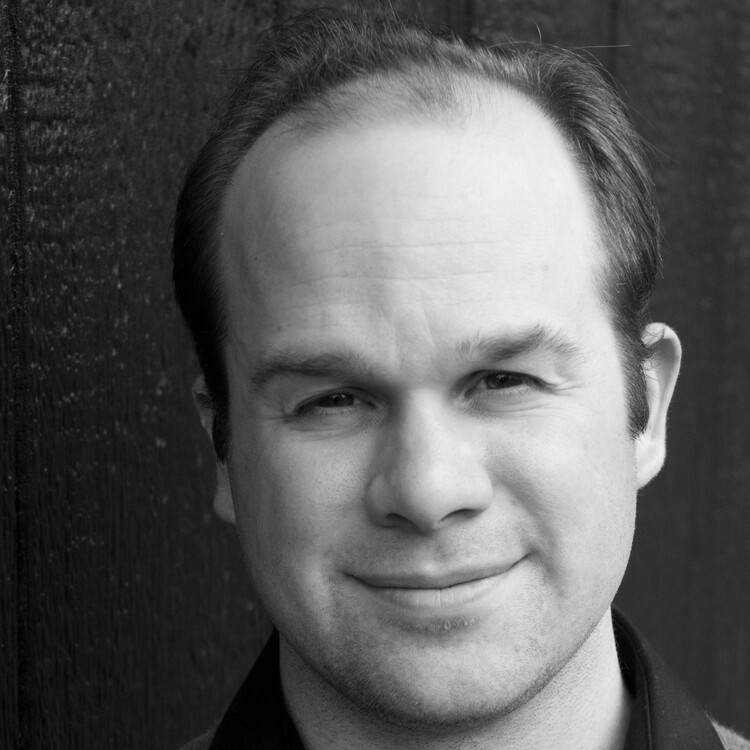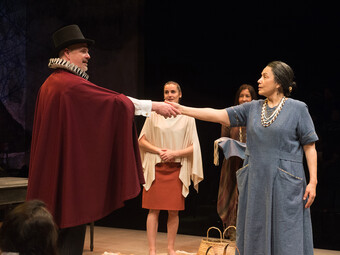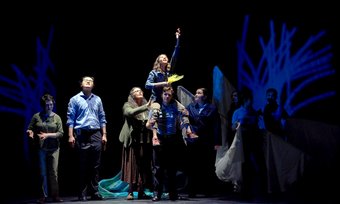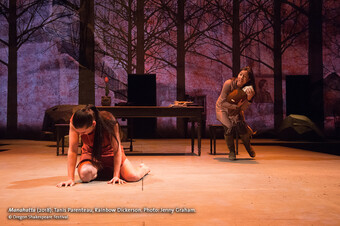Native Theatre in Oregon
Today I introduce myself as a Karuk dramaturg, but it wasn't until six years ago that I would even have thought to put those two words together. Growing up as an Indian theatre student in Oregon, my social life was split in two: my (mostly white) theatre friends and my Karuk friends and family. I joke that I had to move across the country to even realize there was such a thing as “Native theatre.” One evening, shortly after I'd moved to Long Island to pursue a graduate degree, a friend asked me if I'd ever heard of Native Voices at the Autry. Learning about their work and creating my own Native theatre defined my MFA candidacy, and I thought to continue pursuing that work with my own people when I returned to the West Coast, dramaturgy diploma in hand.
The situation when I returned, however, was not much different from how it had been when I'd left: the Native and theatre communities in Oregon are still too far apart for Native theatre to happen here with any kind of consistency. Looking into our communities, I decided that the best place to start bridging Oregon's Indian and theatre worlds was the public university system. Most of the Oregon University System liberal arts colleges have structures for supporting Native communities built into their institutions, and they all have undergraduate theatre departments. Working with the Theatre and Ethnic Studies Departments and the Native American Longhouse at Oregon State University (OSU), I presented readings of two plays by Native authors this February to get a better idea of what it would take to create sustainable structures for the development and production of Native theatre in the Beaver State.
The OSU readings weren't the first such event in Oregon, however. In research for this article, I spoke to Brent Florendo at Southern Oregon University (SOU) and Theresa May at the University of Oregon (UO), both of whom have presented Native work at their respective universities. All three projects seem to confirm my initial hypothesis that Oregon's public universities are the best places to start building ongoing Native theatre since their Native community centers function as hubs of urban Indian community, and their educational mission is ideal for creating theatre with nonprofessionals.
Oregon's public universities are the best places to start building ongoing Native theatre since their Native community centers function as hubs of urban Indian community, and their educational mission is ideal for creating theatre with nonprofessionals.
Precedents: Salmon Is Everything
While Theresa May's Salmon Is Everything has been produced in both Oregon and California, its genesis happened primarily on the California side of our border, at Humboldt State University in Eureka. This brings up an important point about borders: while they look firm and set on the map, culturally they can be porous as a sieve. While the Oregon-California state line is a political reality, the border counties are so close culturally that they're colloquially called “The State of Jefferson.” The crisis out of which Salmon Is Everything sprang is a perfect example of the complicated socio-political relationship. In September 2002, thirty-four thousand salmon washed up dead at the mouth of the Klamath River in northwest California, a catastrophic result of that year's drought and the ensuing conflict over water between the farmers and ranchers upriver of the Klamath River dams in Oregon and the tribal and commercial fishers downriver in California.
Theresa May, a non-Native ecodrama practitioner in her first year on the theatre faculty at Humboldt State University (HSU) in Eurkea, approached Suzanne M. Burcell of HSU's Indian Teacher and Educational Personnel Program (ITEPP), which acts as the hub of Indian community on campus about collaborating with Native community on an ecodrama about the fish kill. The Klamath Theatre Project emerged in 2003 as a collaboration between theatre and ITEPP with grants from the President's Office and the Multicultural Center, led by May, to address the crisis. Creative process began as a combination of interviews by the students with the local community, and by free-writing on the part of the students. As May related in her book, in the talkback after the first reading, “one elder opened a door that shifted the conversation. ‘We need the farmers' stories too! We need to invite them down for a salmon dinner after the play!’” Fortunately, while May had been working with the Indian community from below the dams, Bob Chadwick and Terry Morton of Consensus Advocates had been instigating a series of stakeholder meetings with farmers, ranchers, commercial fishers, and government officials to “mitigate polarization.” May attended three of the sessions, and the oral testimonies of the participants helped to shape the characters from above the dams in Salmon Is Everything. As the play approached its final form, May struggled to cast the Indian roles with Indian actors.
Casting Native actors in the Native roles presented the primary challenge at both HSU and UO. When I spoke with her, May told me that “In a theatre department, at least at the University of Oregon, there are very few actors of color.” By continuing her networking with the local Indian community, however, May was so successful at HSU that not only did she fill all the Indian roles with Indian actors, she had to write in a new character for a young man that everybody wanted to be there. When she began teaching at UO, she took three years to get to know the Native community in and around Eugene before she was able to cast Salmon Is Everything.
Raccoon Earns His Stripes
Before Brent Florendo was a Wasco Native American Studies professor at Southern Oregon University, he was a Wasco theatre student at Southern Oregon University with a background in musical theatre. To earn his bachelor's degree, he created the concept for theatricalizing one of his family's traditional stories for his capstone project. Upon joining SOU's faculty, he pushed for his old department to produce Native theatre. Frustrated by their lack of interest, he started a Native theatre class within the Native American Studies department. The theatre department approached Florendo in 2011 about turning his People's traditional stories into a musical. The theatre department gave him a ten-student workshop for fall term in 2012 to develop Raccoon Earns His Stripes. A theatre department mainstage production, Raccoon Earns His Stripes drew its audience from both the local Ashland community, including members of the Oregon Shakespeare Festival (OSF), and from the Coquille Tribe, which bused students to Ashland to see Florendo's play.
When I asked Florendo about the challenges he faced in creating Raccoon Earns His Stripes, he contextualized the theatre department's initial disinterest in the broader sociological environment within which Native theatre professionals need to strive. Simply put, most Americans don't expect Indians to be modern people; they expect drums and feathers. Within the cultural microcosm at SOU, Native theatre didn't read as artistically valid to the theatre department. Their mission is to prepare their students for careers as theatre professionals, and they maintain a close connection with OSF. To date, OSF has not produced a Native play, with the tenuous exception of Tracy Letts' August: Osage County. Florendo also told me that one of the challenges in producing and teaching Native theatre at SOU is teaching non-Natives to represent Native people respectfully: like HSU and UO, SOU's Theatre Department is heavily non-Native.
Most Americans don't expect Indians to be modern people; they expect drums and feathers.
The OSU Readings
When I returned to Oregon after earning my MFA in New York, my best opportunity for professional Native performance was telling traditional Karuk stories to Title VII students in public K-12 schools. I quickly realized that, if I wanted to do Native theatre in Oregon's segregated cultural sector, I needed to find institutional communities with their feet in both the Native and theatre ponds. My work at OSU came out of a spate of networking that I undertook during 2014 to discover opportunities for Native theatre in Oregon. I met Natchee Barnd, an ethnic studies professor, in a pretty typically Indian fashion—through a cousin (specifically, one of her relatives married one of my relatives several generations ago, and we grew up together, so, “cousin”). Barnd in turn introduced me to Charlotte Headrick, a professor in the theatre department. Earlier in her career, Headrick taught on the reservation of the Alabama-Coushatta Reservation of Texas. She's maintained an interest in Native America, and has for the past several years taught a William S. Yellow Robe play. Also through Barnd, I met Luhui Whitebear, the Internal Coordinator for OSU's Native American Longhouse. I brought up my idea of presenting a series of readings of plays by Native authors. All three were interested. The plays we picked were Drew Hayden Taylor's In a World Created by a Drunken God and Yvette Nolan's The Unplugging. I liked these plays because, while written by Canadians (Taylor's Ojibwe from Ontario and Nolan's Algonquin from Saskatchewan), they both deal with themes that I felt would resonate with Oregon audiences, Native and non-Native. In a World... is a kitchen sink dramedy (funny drama, or weighty comedy) that deals with universal themes like yearning for family, as well as rifts within families caused by Anglo colonization in North America and the ensuing cultural divides between Indians and whites and between Canadians and Americans. The Unplugging is post-apocalyptic soft sci-fi, genres well-established with popular audiences.
Dramaturgically, both plays read as familiar to audiences foreign to Native performance structures. I figured they would be appealing to a wide swath of Corvallis' community. We received a grant from OSU's vice provost of student affairs, and began the tortuous process of casting. I was firm that I wanted Native readers for the Native roles. We reached out to Corvallis' Native community through an OSU press release and Headrick's professional network. The week of the readings, one of our readers had to back out due to an unexpected work conflict. Ethnic Studies' Office Specialist, Leonora Rianda, volunteered to step in. Rianda's not Native, but she was excited about the work, and we had more to gain by presenting the readings rather than aborting the project. Besides Rianda and Kyle Stockdall, a theatre student who read Seamus in The Unplugging, none of my readers had done any acting before. Since we were presenting readings and didn't need to worry about memorization or blocking, I was free to focus as a director on acting basics like objectives and relationships between characters. After a short rehearsal process, we presented the readings in the Longhouse. For both plays, our audience consisted of friends and family of the participants, and the communities from the Longhouse and the theatre department.
Recommendations
The OSU experiment, as well as May and Florendo's respective projects, confirm my initial assessment that the state universities are the best places to create sustainable structures for the development and production of Native theatre in Oregon. It also lends clarification to what the next steps should be. First, we need to treat Native theatre here as community theatre. Many of our initial collaborators will not be students, especially not theatre students. Instead, we need to work with our whole Native communities. “Communities” in this sense is smaller than Oregon; for Native community theatre based out of university structures, we need to think about the Native community within commuting distance of campus. While the initiating artist can be from outside that Native community, as in the case of May at HSU and U of O, they should also be within commuting distance of the school. If it hadn't been for Headrick's already extensive network at OSU, and her willingness to use it to execute our project, the OSU readings never would have happened. At HSU, May systemized a scheduling system that worked well with the erratic schedules that many of her collaborators had, and that I started to fall into just by accident at OSU—work with who shows up. Finally, May and I both used texts that, while rooted in the Native communities, were accessible to the larger community in which we created work. This speaks to inviting non-Natives into Native spaces for theatre purposes.
Since the best organizations for creating Native theatre here are schools, and we don't already have a trained corps of Indian actors, the next step in Oregon Indian theatre needs to also be as educational theatre. May and Florendo created their pieces with a workshop process at HSU and SOU, and I taught basic acting as part of directing the readings at OSU. If Native theatre can be integrated with the theatre education that university theatre departments already engage in, Native theatre can be a recruitment opportunity for heavily white theatre departments.
For Further Reading
May, Theresa. Salmon Is Everything: Community-Based Theatre in the Klamath Watershed. Corvallis: Oregon State University Press, 2014.









Comments
The article is just the start of the conversation—we want to know what you think about this subject, too! HowlRound is a space for knowledge-sharing, and we welcome spirited, thoughtful, and on-topic dialogue. Find our full comments policy here
Thanks for writing this Waylon! Please consider including Phoenix Blues, a one man show, by native artist Phoenix Sigalove, I developed and directed at The Oregon Shakespeare Festival in our inaugural year of OSF Presents 2012. Most of the indigenous work I present, as you know, is primarily song and dance in the Green Show and in the community collaborative performances like the Martin Luther King Celebration. We've consistently presented indigenous artists since I began working at OSF in 2008. Phoenix Blues was a theater piece that I was proud to be a part of I hope you can include it in your list of Oregon Art!
Thanks for your note, Claudia! I understand that OSF has commissioned Rhiana Yazzie to write a play, that they present the final performance of Konaway Nika Tillicum (a summer camp for Native youth), and that, besides Phoenix Blues, you annually present several Native pieces in the Green Show. That means I should clarify: besides the controversial August: Osage County, we're still waiting to see Native theater as part of the regular season.
A couple corrections Charlotte Headrick asked me to make: the photo is of the reading of In a World Created by a Drunken God, and the readers are Richard Wendland, Kenneth Runningcrane-Real, and Mike O'Malley. Charlotte also didn't teach on the Alabama-Coushatta Reservation, but rather directed Kermit Hunter's Beyond the Sundown there. Apologies!
Kia ora Waylon - great article and positive proof of 'modern' Indians. I think you're totally right, that universities can lead the way in forging paths to create Native theatre with loyal Native communities.
Sorry, that should read local Native communities.